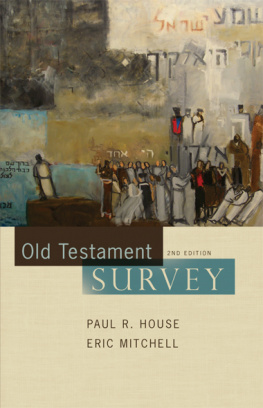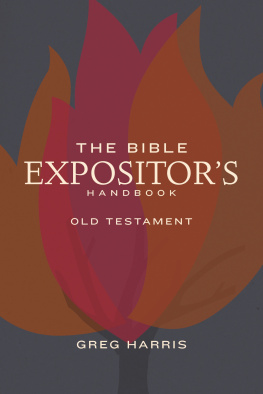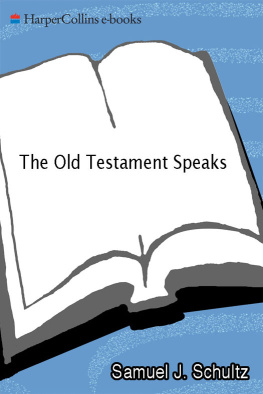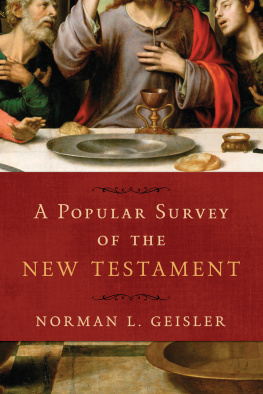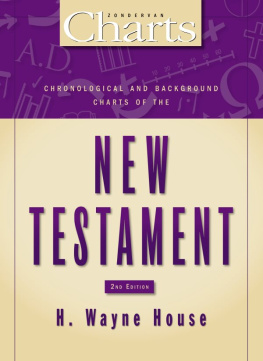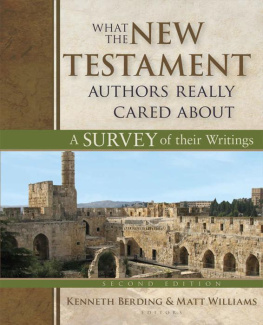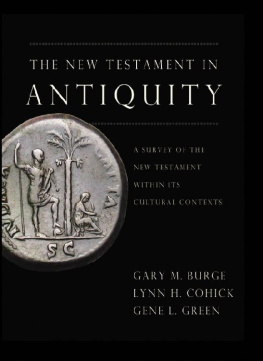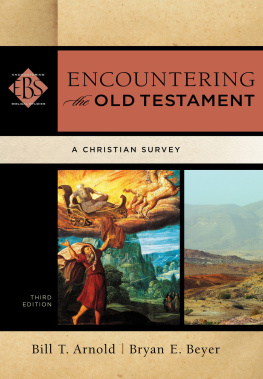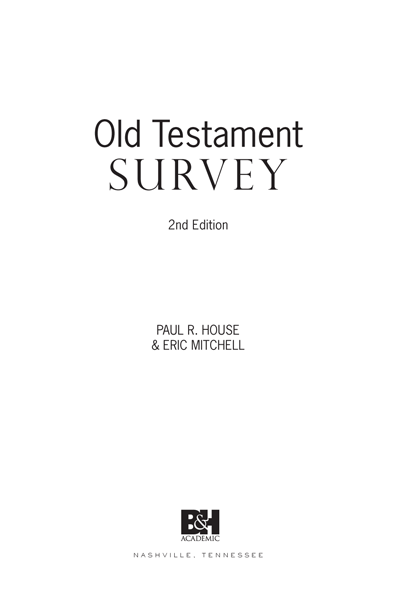

____________________________
To Suzanne House Kingsley
and
Barbara Hester Mitchell
and
Mitch Mitchell (19332006)
____________________________
PREFACE
Sometime in 1990 Dr. Trent Butler offered me a contract to write an introductory work on the Old Testament that would serve as a textbook for college freshmen and others needing a guide to the Old Testament. In 1991 I finished the manuscript of Old Testament Survey in the offices of Youth for Christ, Singapore, where I had been teaching an introductory Old Testament class and helping lead a student mission trip. Trent was helpful at every step of the process, as was Dr. Steve Bond. Over the next 15 years several thousand copies of the first edition were sold, and from time to time I was honored to hear from students who appreciated the volume.
In 1996 I met Eric Mitchell, who was at that time a doctoral student at The Southern Baptist Theological Seminary. He agreed to serve as my teaching assistant, and I quickly came to appreciate his good scholarship and generous spirit. As it became evident that we needed a new edition of the book, I was pleased that Eric agreed to collaborate in the project. One of the ways I felt the book needed to be improved was in the area of historical backgrounds. Since he is a gifted historian and archaeologist, I knew Eric would make an excellent partner.
We decided that I would revise the analysis of the contents of the Old Testament, and Eric would write segments intended to provide greater historical insight into the biblical text. He also agreed to choose maps and other visual aids for the book and to write a more thorough treatment of the ancient world for the opening section. Of course, we share responsibility for the book's statements. We also share a commitment to the truthfulness and accuracy of God's Word that we believe is justified on scholarly grounds as well as theological ones.
Like the first edition, this edition attempts to help beginning students understand the Old Testament. We define beginning student from our experiences with college freshmen, serious church study groups, and seminary students. Such students range in age from 18 to 80. They are intelligent and willing to learn, but they need guidance and motivation to study a part of the Scriptures often thought irrelevant in our culture. Most of these students do not know the Old Testament story, its unity, or the basic scholarly viewpoints that help interpret it. Thus, we have tried to write this book for the benefit of students, yet with the intent of leaving other instructors plenty of room to develop historical, theological, and critical issues.
Several people deserve our thanks for their aid on this project. Dr. John Landers, our editor, was enthusiastic about the project from the start, and we received crucial guidance from the whole team at B&H Publishing Group. My assistant, Elizabeth Baker, provided excellent support in the preparation of the manuscript. We also want to thank our graphics artist Ray Pomerico who contributed all the figures and who did the technical editing of the maps.
Our families were also helpful. Our wives, Heather House and Nancy Mitchell, were encouraging and insightful during the process. They provide on a daily basis a great environment for writing and teaching. Heather, who is a freelance editor of Christian books, edited parts of the volume. Eric's four children, my daughter, Molly, and her husband, Martin, gave great encouragement. We are thankful that our families share our faith in the triune God revealed in the Bible.
This book is dedicated to some special people. Eric's parents have long supported his ministry efforts. Sadly, his father died while this book was being written, but his mother remains, still serving the God who raises the dead. My sister Suzanne has long stood with me regardless of the circumstances. Her faith, courage, grit, and determination give flesh to the apostle Paul's assertion that love never fails. She has recently survived cancer surgery and treatments to continue life with Gordon, whom I love as well.
For these and other kindnesses, we are grateful.
Paul R. House
Eric A. Mitchell
LIST OF TEXT MAPS
LIST OF COLOR MAPS
(See insert following page 368)
Modern States and the Ancient Near East
Modern Political Divisions of Ancient Palestine
The Ancient Near East in the Time of the Patriarchs
Natural Regions of Ancient Palestine
International Routes
Climate Patterns of Ancient Palestine
Egypt and Palestine in the Late Bronze Age
The Route of the Exodus
The Land from 12001000 BC: The Iron I Period
Limits of Israelite Settlement and the Land Yet to Be Conquered
Kingdom of David and Solomon
Jerusalem in the Time of David and Solomon
The Kingdoms of Israel and Judah
Hezekiah's Jerusalem
World Powers of the Sixth Century BC
The Persian Empire
LIST OF CHARTS AND ILLUSTRATIONS
BEGINNING THE STUDY
INTRODUCTION
For centuries Christians and Jews alike considered the Old Testament a unified work. Jewish readers viewed the Hebrew Scriptures as a thorough account of their faith and history. Christians treated the Old Testament as the natural introduction to their New Testament. Neither group failed to acknowledge the many types of literature in the books, but both communities of faith found underlying themes and characters that bound the whole together.
In the last two centuries, however, the diversity of the Old Testament has been stressed. Children are taught that the Bible is not a book but many books. College and seminary students often analyze each biblical book in isolation from other Scripture. Therefore many individuals have little sense of the wholeness of Scripture. Few people can fit specific stories into a larger biblical picture. Lacking a grasp of the overall Old Testament plot and purpose, Bible students struggle to understand particular passages.
This book attempts to chart some elements that unify the Old Testament. Its purpose is to serve as a companion to Bible reading. Characters, plot, structure, themes, and historical settings are highlighted so the reader will know what is happening in the Old Testament. Theology and criticism are not absent, but they play a secondary role. The reader is referred to more detailed studies of these subjects. This book seeks to help readers appreciate the unity of the Old Testament. If students can master the introductory principles this book covers, they will then be prepared to move on to further study.
ORDER OF THE STUDY
Every Old Testament survey must choose a way to approach its subject. Some authors stress the theological content of the books. Others describe in detail the historical background of the Old Testament. Beyond these concerns many textbooks explain the books according to when they appear in the English Bible. Still others assemble the texts in historical order. For Christians it seems logical to study the Hebrew Bible as the early church did.
The first disciples only Scripture was the Old Testament. They believed it was inspired by God as their guide for faith and action (2 Tm 3:16). Their Bible was divided into three specific parts: the Law, the Prophets, and the Writings (see Lk 24:44). That order will be followed throughout this book. Notice how the order of the books in the Hebrew Bible differs from the English Bible:
Next page
